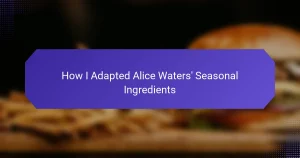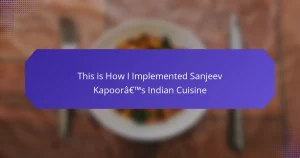Key takeaways
- Innovative cooking blends tradition with creativity, transforming simple ingredients into extraordinary dishes.
- Heston Blumenthal’s techniques, such as sous-vide and molecular gastronomy, encourage chefs to experiment with flavors and textures.
- Cooking challenges can enhance creativity, foster community engagement, and develop culinary skills.
- Personal experiences with Blumenthal’s methods highlight the joy of experimenting and learning from both successes and failures in cooking.

Introduction to Innovative Cooking
Innovative cooking is a delightful dance between tradition and creativity. It transforms mundane ingredients into extraordinary dishes that surprise and inspire. I feel that every time I experiment in the kitchen, I’m on a journey to rediscover flavors and techniques that elevate my meals beyond the ordinary.
When I first encountered innovative cooking techniques, I remember the sheer excitement I felt trying molecular gastronomy at a culinary workshop. The idea of using science to manipulate food into unique textures and presentations was both intimidating and exhilarating. Have you ever experienced that feeling of wonder when a dish looks like art yet tastes like a comforting memory?
This approach encourages chefs and home cooks alike to step outside their comfort zones and explore new possibilities. I often reflect on how a simple dish can become a canvas for imagination, making cooking not just a routine task but an adventure. Innovative cooking invites us all to play, experiment, and enjoy the process as much as the outcome.

Overview of Heston Blumenthal’s Techniques
Heston Blumenthal’s approach to cooking goes beyond mere recipes; it encapsulates a philosophy of experimentation and sensory experience. His techniques often blend science with culinary art, inspiring both home cooks and professional chefs to think outside the box. I still remember my first time attempting one of his recipes—it was a rabbit stew with a twist, showcasing how unconventional methods could create extraordinary flavors.
What stands out to me about his techniques are how they evoke emotions and stir curiosity in the kitchen. I’ve tried several of his methods, such as sous-vide cooking, which emphasizes precision and control. The soft textures and enhanced flavors are nothing short of magical. Here are some key techniques Blumenthal uses:
- Sous-vide: Cooking food in a vacuum-sealed bag in a water bath at precise temperatures for tenderness.
- Molecular gastronomy: Integrating scientific principles to alter the physical and chemical structure of ingredients.
- Flavor pairing: Using complementary flavors based on the science behind taste, which opens up a world of culinary possibilities.
- Textural contrasts: Combining different textures in a dish to create a more engaging eating experience.
These techniques not only redefine traditional cooking but also invite us to explore the endless possibilities within our kitchens.

Key Elements of Innovative Recipes
When I think about innovative recipes, particularly those inspired by chefs like Heston Blumenthal, several key elements come to mind. One of the most fascinating aspects is the use of scientific techniques to elevate traditional cooking methods. I once tried a spherification technique he popularized, and it completely changed my perception of flavor presentation—who knew that a burst of juice could bring such excitement to a dish?
Additionally, creativity in ingredient combinations cannot be overlooked. Whenever I experiment in my kitchen, I remember a dish I tried that combined unexpected elements like lavender and savory lamb. The harmony of those flavors was not only surprising but also transformative, proving that taking culinary risks can lead to extraordinary results.
- Use of molecular gastronomy techniques, like spherification and emulsification.
- Creative flavor pairings that challenge traditional notions.
- Attention to presentation and sensory experiences, making dishes visually stunning.
- Incorporation of seasonal and local ingredients for freshness.
- Experimentation with textures to enhance the overall dining experience.

Benefits of Cooking Challenges
Absolutely! Cooking challenges can be a fantastic way to push your culinary boundaries. For me, participating in these challenges has not only boosted my confidence but has also sparked my creativity in the kitchen. When I first tried Heston Blumenthal’s innovative techniques, I was amazed at how they transformed my approach to cooking, making every dish an adventure.
Moreover, these challenges often foster a sense of community. Sharing experiences and recipes with others who are equally passionate about cooking can be incredibly uplifting. I remember a particular challenge where I collaborated with friends to create a multi-course meal—seeing everyone’s unique interpretations was a highlight of my culinary journey.
Here’s a comparison table showcasing some key benefits of cooking challenges:
| Benefit | Description |
|---|---|
| Creativity Boost | Encourages outside-the-box thinking and experimentation with flavors. |
| Skill Development | Enhances cooking techniques and introduces new cooking methods. |
| Community Engagement | Builds connections with fellow cooking enthusiasts for shared learning. |

My Experience with Blumenthal’s Methods
When I first tried Heston Blumenthal’s sous-vide method, I was captivated by its precision. Cooking a steak for hours at a perfect temperature seemed intimidating, yet the result was an incredibly tender piece of meat with flavors sealed in beautifully. Have you ever waited patiently for a dish to transform in such a remarkable way? That anticipation added an extra layer of thrill to the cooking experience.
One method that truly resonated with me was molecular gastronomy. I remember experimenting with spherification for the first time. Watching little bubbles of fruit juice pop in my mouth was a game-changer. It wasn’t just about the taste; the excitement and surprise added a whole new dimension to the dining experience. I’ve found that using these techniques allows me to reconnect with food in ways that feel like magic.
Not every attempt has gone smoothly, though. I recall a time when I tried to create a dessert using flavor pairing, yet the combination fell flat. Instead of feeling discouraged, I learned the importance of balancing flavors—something Blumenthal emphasizes. It’s remarkable how even failures can teach valuable lessons and inspire improvement, don’t you think? Embracing these methods has made cooking an ongoing adventure, filled with moments of discovery and delight.

Favorite Recipes Inspired by Heston
When I think of Heston Blumenthal, I’m transported to the vibrant world of flavor science. His creative approach to cooking has inspired me immensely. For instance, I once tried my hand at his celebrated “Baked Alaska,” which is not just a dish but a culinary experience that challenges traditional expectations with its mix of hot and cold sensations.
Another favorite of mine is his “Nitro Poached Ice Cream.” The thrill of working with liquid nitrogen was both exhilarating and slightly nerve-wracking! The result was a smooth, creamy ice cream that froze before my eyes, showcasing Blumenthal’s knack for marrying technique with artistry. These recipes not only taste incredible, but they also spark curiosity and encourage experimentation.
Here’s a comparison table of my favorite Heston-inspired recipes:
| Recipe | Key Features |
|---|---|
| Baked Alaska | Combines meringue, cake, and ice cream for hot & cold contrast |
| Nitro Poached Ice Cream | Instant freezing technique using liquid nitrogen for unique texture |


